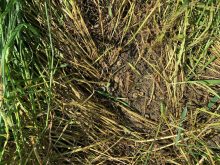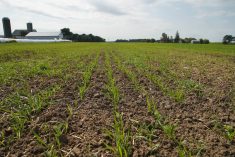With another winter wheat season complete, participants in the Great Lakes Yield Enhancement Network (YEN) continue learning how the farmer factor — what a grower does, and when — can make or break top yields.
Why it matters: Timing is everything when it comes to achieving high winter wheat yields.
Speaking at an Aug. 7 Ontario Soil and Crop Improvement Association event, Marty Vermey, senior agronomist for Grain Farmers of Ontario, says the fourth annual YEN competition highlights how throwing the kitchen sink at winter wheat is no performance guarantor.
Read Also

The forced Japanese-Canadian farmers of the Second World War
Manitoba’s sugar beet farms drew on displaced Japanese-Canadians from B.C. during the Second World War
Instead, earlier planting, constant monitoring and good in-season timing appear to matter most.
What is YEN?
The Great Lakes YEN was launched in 2021 by the Grain Farmers of Ontario, Ontario Ministry of Agriculture, Food and Agribusiness, Michigan Wheat Program, Michigan State University, the University of Guelph and Certified Crop Advisors.
Based on a model from the United Kingdom, the network’s purpose is to help farmers and industry build insights and knowledge about factors affecting winter wheat yield.
“Why are some farms producing large grain outputs, while others are struggling and trying to figure out how to improve their productivity?” asks Vermey, describing the base question behind YEN.
“What’s involved is we have crop modeling. That’s where researchers really help us out with this project. They calculate yield potential. It’s crop modeling taking solar radiation, rainfall, water holding capacity — all those scientific things, putting them together in a big model, and figuring out the different yield potential for each farmer…
“We figure out what is your potential, and what have you achieved as a percentage of your potential.”
Additional data are collected on nutrient and climate analysis. Tours and other knowledge-sharing activities are also a characteristic of the network.
“It’s a networking event for farmers to talk to each other and understand what others are doing, and adapting different techniques or technologies … It’s really to better understand what impacts yield.”
Lessons to date
The best winter wheat yields can come from otherwise average soils, says Vermey. Some top producers grew their crops on soil with middling water holding capacity.
“Also, the rainfall. The top 10 producers last year had just slightly less than average rainfall, so you can’t just say they had more rain and that gave them a higher yield,” says Vermey.
“The higher yielding ones also had a high potential, but they were only really average as far as what was their calculated yield potential was. So that would suggest they’re probably an average farmer. Something else is going on, because their field was just average, but they achieved a higher yield.”
The U.K. YEN program found that only one per cent of yield came from variety selection, while 25 per cent came from the farmer factor — what the farmer does, when they do it, and how much. This includes everything from seeding rate and row spacing to nutrient application.
Analysts are in the process of crunching data from four years of Great Lakes YEN to determine the local farmer factors.
Vermey says top producers are “building a bigger plant sooner.” That means planting earlier in September, with a lower seeding rate, resulting in more tillers in autumn and lower disease pressure.
Regarding nutrients, the top yielding participants tend to apply slightly more nitrogen but lower than average amounts of phosphorus and potassium. Vermey says it’s possible their soils are already “built up” with those nutrients. However, better placement for phosphorus and potassium, both of which move little in soil, also makes a difference.
Using standardized costs for application and inputs in YEN calculations, Vermey says the top producers had average per acre production costs.
“That really shocked us when we looked at it. We really thought it would be those who are spending more. More fungicide applications, more nitrogen applications. There are some farmers doing different things, pouring the kitchen sink at it, but it didn’t give them the returns.”
The critical factor — the proverbial Great Lakes farmer factor — is how closely growers monitor their crops through each growth stage. More monitoring provides a better chance to apply management techniques at the optimal time.
“That’s probably what every high-yielding farmer told me. The timing just worked out,” Verwey says.















